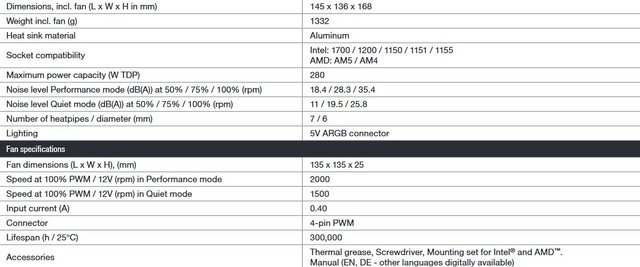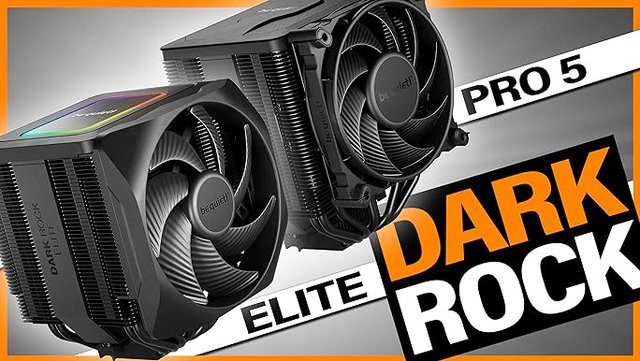-
be quiet! Dark Rock Elite & Dark Rock Pro 5
Introduction
be quiet! are a popular choice for those looking for quiet and aesthetically quiet cooling solutions with their products ranging from fans, cases, PSUs and CPU coolers of which they have today announced two new models within their lineup. The all-new Dark Rock Elite and the updated Dark Rock Pro 5 both offer a dual tower design with cutting-edge cooling performance. Succeeding the Dark Pro 4, be quiet! says the Elite and Pro 5 surpass the performance of their 2018 predecessor with a 280W and 270W rating, respectively. With this update, the brand aims to improve performance while keeping things compatible and easy to use. Plus, there’s a pinch of RGB for some flair. In addition to the framed frontal fan, the premium Dark Rock Elite also comes with a rectangular RGB strip on the heatpipes cover, controllable via the motherboard. Both feature a speed switch offering a choice between performance and silence without requiring any software or BIOS configuration. And good old PWM control is still available for those who like manually tweaking their fan curves. To maintain wider compatibility, these coolers have an asymmetric seven heatpipe layout, leaving more room for the heatsinks on motherboard VRMs. And, for RAM support, the Dark Rock Elite has a five-step rail system on the frontal fan, so you can install up to 63.3mm tall memory modules – the Dark Pro 5 uses a basic adjustable metal retaining mechanism.

The Dark Rock Elite and Dark Rock Pro 5 are compatible with Intel LGA 1700, 1200, 115X, and AMD AM5 and AM4 sockets.

Packaging & Contents
The box is, as typical for the manufacturer, designed in black and only the orange in the logo some contrast. The front of the box features the be quiet! Logo in the upper right hand corner. A large picture of the product in the middle with the Name of the Product Model. The top of the box just mentions the product name, and maximum TDP of 230W.

The back details the features. This is done using both images and a in depth description of the product.

The left side has a QR code for quick access to product information. Turning to look at the left side of the box, we find a specifications table detailing most of the information buyers will find pertinent. This includes the cooler's weight, dimensions, fan RPM, and supported sockets.

The packaging is mostly cardboard, but be quiet! did slip some foam in to protect the heatsink and fan, which is always nice to see. The mounting hardware is kept secure in a smaller box, while a flap on the top helps secure everything in smaller, separate compartments.

The accessory section is housed in a small cardboard box. Whether you’re dealing with a Dark Rock Pro 5 or a Dark Rock Elite, the accessory section remains identical. The box features:
Assembly instructions
A warranty guide
Intel multi-socket backplate with arms and accompanying hardware
Mounting arms for AMD sockets
A syringe of thermal paste
Long screwdriver


A Closer Look Dark Rock Elite
Equipped with its two fans, the cooler measures 146 mm thick with a height of 168 mm and a width of 136 mm. The weight with fans is 1.34 kg.

The aluminum cooling fins are made by be quiet! coated black. The coating contains ceramic particles that are intended to ensure good heat transfer. The two towers are approximately 4 cm wide. They have a stack of 46 fins, but the lowest nine fins are shorter, in order to optimize compatibility with memory modules. It is thus possible to place memory modules 63 mm high, by raising the external fan. Under the fan there is a gap just 32mm high.

When you look at the cooler sides, you can see the dual tower structure. Both coolers have a 135 mm fan between the cooling towers. This fan does not have a standard frame, but rather a frame with labels on the side that is slanted at the bottom.

The Dark Rock Elite has a very simple cover, on which the large, silver-colored be quiet! lettering is particularly noticeable. It frames an A-RGB LED ring that surrounds the central aluminum badge with the manufacturer's logo.

Beneath this cover, which is held in place by magnets, we find the famous switch labelled “P” or “Q” for “Performance” or “Quiet”.

The cover is connected to the inner fan. After the resistance of some retaining lugs has been overcome, both can be pulled out together. The fans can be connected to each other via a special connector and then operated via a single PWM connector on the motherboard. The connection cable is quite short and is therefore well suited for connecting to a PWM connection near the base. There is also an A-RGB cable attached to the Dark Rock Elite.With the Dark Rock Elite, both fans are limited to 1,500 rpm. The Dark Rock Elite's fans both run at up to 2,000 rpm in “P” mode. On the Elite model, we find a Duo of Silent Wings in 135 mm, with seven fine but strongly curved blades. The format also means that replacing them in the event of a problem will be tricky. The front-mounted fan has a flattened frame at the corners, while the center-mounted fan is attached to a structure that includes the upper part of the heatsink… In addition to having a completely non-standard shape.

The construction is very good, it is based around 7 heat pipes with a diameter of 6 mm. They of course pass through the cold plate made of copper coated with nickel. The latter also receives a small radiator to dissipate some calories. The cold plate has a size of 45 x 40 mm, guaranteeing perfect coverage of recent Intel and AMD processors. The finish is very good, CNC machining gives a real mirror, without traces of machining.

A Closer Look Dark Rock Pro 5
Equipped with its two fans, the cooler measures 145 mm thick with a height of 168 mm and a width of 136 mm. The weight with fans is 1.29 kg.

The two towers are approximately 4 cm wide. They have a stack of 46 fins, but the lowest nine fins are shorter, in order to optimize compatibility with memory modules. It is thus possible to place memory modules 65 mm high, by raising the external fan. Under the fan there is a 45mm high gap. It is based around 7 heat pipes with a diameter of 6 mm. They of course pass through the cold plate made of nickel-plated copper. The latter also receives a small radiator.

The Dark Rock Pro 5 has a very simple cover, on which the large, silver-colored be quiet! lettering is particularly noticeable. For this purpose, grid elements are used as a design tool.

The lid of the Dark Rock Pro 5 sits magnetically on the cooler, just like the outer plastic ring of the Dark Rock Elite. The cover underneath is connected to the fan. Under this hood, we find the Speed Switch allowing you to switch from P (Performance) mode to Q (Quiet) mode. This frame is also equipped with magnets. They will help maintain the finishing cover of the Dark Rock Pro 5. The latter bears the brand, it is made of plastic with small openings in two vents.

The cover is connected to the inner fan. After the resistance of some retaining lugs has been overcome, both can be pulled out together. The fans can be connected to each other via a special connector and then operated via a single PWM connector on the motherboard. The connection cable is quite short and is therefore well suited for connecting to a PWM connection near the base. Quiet mode limits the maximum speed of the Dark Rock Pro 5 to 1,500 rpm for the front fan and to 1,300 rpm for the middle fan. In performance mode, the maximum speed for the front fan of the Dark Rock Pro 5 is increased to 2,000 rpm and that of the middle fan to 1,700 rpm.

The Dark Rock Pro 5 has a central fan identical to that of the Elite, the front fan is a standard 120 mm. In fact, it’s a Silent Wings 4 that doesn’t give its name. You can recognize it by the shape of its particularly curved and pointed blades.

The cold plate has a size of 45 x 40 mm, guaranteeing perfect coverage of recent Intel and AMD processors. The finish is very good, CNC machining gives a real mirror, without traces of machining.

Installation Process
For installation, you’ll need to keep your AMD backplate, as be quiet! doesn’t supply one. The first thing to do with an Intel motherboard is to prepare the backplate. To do this, you’ll need to thread screws into the four corners of the backplate, and secure them with rubber washers. On the AMD side, you’ll simply need to dismantle the board’s original mounting arms before moving on.

The next step is to fit the mounting arms around the motherboard socket. To do this, spacers must be installed at the four corners of the socket. On the Intel platform, these will be screwed onto the backplate, while on the AMD side, the plastic ones simply need to be removed.



Remove the protective sticker from the base of the CPU block, lower down the CPU block aligned with the mounting screw holes and tighten the screws to fix the CPU block in place. Be sure to tighten the screws evenly and progressively for optimal CPU block to CPU contact. In order to screw the cooler to the mounting bridges, the middle fan must first be pulled out. The deep-seated mounting screws can then be easily accessed with the included screwdriver. For connections, each fan plugs into a fan port.

The clearance for the first DIMM slot from the Dark Rock Elite heatsink itself is 63mm. However, this clearance reduces to 32mm after installing a front fan in its default position. You can adjust the height of the front fan to make room for high-profile RAM by up to 71mm. This will increase the overall height of the cooler to 208mm and this would impact the PC Case’s CPU Clearance.

The clearance for the first DIMM slot from the Dark Rock Pro 5 heatsink itself is 64.9mm. However, this clearance reduces to 45.4mm after installing the front 120mm in its default position. You can adjust the height of the front fan to make room for high-profile RAM. I am showing the XPG Lancer RGB DDR5 kit which has no such issue.

With the Dark Rock Elite we had to pull the outer fan up significantly. If you want to use this cooler, you should ideally use low-profile memory. This is even more true if the case limits the maximum CPU cooler height. The smaller 120 mm fan in the Dark Rock Pro 5 is OK. When fitted to the motherboard you have a nice solid design that looks bold and professional.

Since the cooler doesn’t include a lighting controller, we connected it to our motherboard’s nearest ARGB header.

And finally, the payoff: The Dark Rock Elite’s ARGB ring can be set to any color and/or pattern that’s offered by the connected ARGB controller.


Testing & Methology
For today's testing, we'll be using a new test setup, so we've also tested a few other coolers as part of it for direct comparison. We have recently equipped our lineup with a Ryzen 9 5950X processor, which is significantly more demanding. Perhaps the most important thing is that we are testing in a classic case, a large and very well ventilated Fractal Design Meshify 2 XL. In addition, it also allows the installation of a 480 mm heat exchanger on the ceiling. We always install the tested AiO coolers with an exchanger on the ceiling, while there are high-quality fans on the front wall of the cabinet for good air access to the cabinet. Very quiet graphics are also installed so that it does not disturb the results.
Testing coolers in practice
What else do you need to know about our testing? We test all coolers without manual adjustment and regulation. We leave everything to automatic regulation, that is exactly how the vast majority of users will use them. Of course, all coolers (and their fans) usually have the possibility of manual regulation, which affects performance and noise. The cabinet used definitely also plays a big role, and above all the temperature in the room. In our case, the temperature during testing is always around 20, maximum 21°C.

AMD Ryzen 9 5950X processor cooling
As for the Ryzen 9 5950X processor, it also plays a big role when comparing coolers. The maximum safe operating temperature of this model is up to 95°C according to AMD. It is only at this point that the processor starts to limit clocks and therefore performance. The processor is actually made up of three separate chips under the heatspreader, so it is not a monolith (one chip). There are two 7nm 8-core/16-thread ZEN 3 and one low-end 12nm I/O pieces of silicon. The two small 7nm chips generate the most heat. In general, a larger chip area is more advantageous for cooling, as heat is dissipated more easily across the surface. However, with the current AMD ZEN chips, which are very small (only around 80mm2), the heat is extremely concentrated (as well as the transistors in the chip themselves) on a very small area. The area through which the chip transmits heat to the heatspreader is very small, which is why there are significant temperature fluctuations.
A processor such as the Ryzen 9 5950X shows significant and rapid temperature changes, depending on the load. This processor can show high temperatures, but that doesn't mean it's heating up, so to speak. It makes a big difference if you have a small 70mm2 chip with a temperature of 80°C or a 200mm2 large chip with the same temperature. The Ryzen 9 5950X is actually extremely efficient with a low base TDP of only around 105W. However, even with powerful cooling, temperature fluctuations between 65 - 85°C in various types of load and 30 - 40°C in idle states are common. In our case, we are testing a typical longer-term load in CineBench R23, and all coolers are left in their own auto-regulation mode, so the fan speed and noise are different. And so here are the main differences.
Performance
As you can see in our charts above, the Dark Rock Elite performed pretty well in our Default test. The Dark Rock Pro 5 finished only 1°C behind the leading Dark Rock Elite combination. This is an amazing result.

Next, we illustrate cooling performance faced with the insane load generated by Intel Burn Test. We don’t think any application will put this much pressure on a CPU, so consider this an absolute worst-case scenario. Of course the 420mm AIO's dominates here, leveraging the tremendous advantage liquid coolers have due to the separation of the radiator from the heatsink. Yes, these AIO's has more cooling capacity, but is it necessary? We think that for most PC builders, it is not. Of course, we bet you can spot the air cooler that runs away from the pack yet again. In the load test, the Dark Rock Elite delivered truly exceptional performance. Keeping the 5950X at 78c with the fans spinning at full speed was more reminiscent of a closed loop water cooler than an air cooler.

As powerful as the be quiet! fans may be, it is able to push air without overwhelming the ears. It's safe to say that be quiet! has another winner in their hands with fans. With all those being said, let's now go to the next page where we will wrap this review up.

Final Thoughts
With these heatsinks, be quiet! offers us models with an exemplary finish. The upper parts of the Dark Rock Pro 5 and Dark Rock Elite feature aluminum, but in different forms. The Elite features brushed aluminum surrounded by an aRGB border. On the Dark Rock Pro 5, the aluminum is sandblasted, more basic. In any case, this part features the brand’s logo at its center with mesh metal parts. The two new be quiet! coolers are almost entirely in deep black. They look quite bulky and are also large at 145 x 136 x 168 mm (L x W x H). In all cases, you’ll need to keep their weight in mind when moving around. It may not look like it, but they weigh over 1 kg on the scales – 1.29 kg for the Pro 5 versus 1.34 kg for the Elite!The Dark Rock Pro 5 is the better choice if RAM and case compatibility are crucial. Pay particular attention to the height: not every case is suitable for 16.8 cm high coolers. With high RAM bars, it may also be necessary to set the outer fan even higher and therefore require even more space. The actual heat sink is the same for both coolers. The main difference is the cover and the external fan. The Dark Rock Pro 5 (left in the picture) has a 120 mm fan, which is mounted in the classic way with fan clips. It should work at a maximum of 2,000 rpm. On the Dark Rock Elite, however, the external fan is a larger 135 mm model. It sits on the radiator with a plastic bracket and can be adjusted in height using rails. This fan also runs at a maximum of 2,000 rpm. However, ventilation is provided by non-standard fans, which means that in the event of failure, it will be difficult to replace them yourself, and you’ll have to turn to the company’s after-sales service. In addition, both models feature a switch to regulate the maximum speed of the grinders, for greater silence or performance, depending on the scenario. The assembly itself with be quiet! is always easy and straightforward and as long as they don't change that part I'm not going to complain. With the Dark Rock Elite we had to pull the outer fan up significantly. If you want to use this cooler, you should ideally use low-profile memory. This is even more true if the case limits the maximum CPU cooler height. The smaller 120 mm fan in the Dark Rock Pro 5 is OK. When fitted to the motherboard you have a nice solid design that looks bold and professional. Our thermal test shows that the Dark Rock Elite has much more to offer if you have a slightly more demanding system and want to use an air cooler. For most users, the Dark Rock Pro 5 will still make more sense, as it is not far behind in terms of performance, but is even quieter and also cheaper. At the same time, the Silent Wings fans ensure good acoustics with plenty of scope - you don't necessarily need the speed switch.

Backed by a three-year warranty, the Dark Rock Elite and Dark Rock Pro are available at $114.90 / €114.90 / £109.99 and $99.90 / €99.90 / £99.99, respectively. Price is still reasonable, where it is close to similar high performance air coolers. be quiet! Dark Rock Elite and Dark Pro 5 impress with outstanding cooling capabilities and near-silent operation, making them flagship models in the realm of CPU cooling.

Last edited by testman78; 12-17-2023 at 09:00 AM.
 Posting Permissions
Posting Permissions
- You may not post new threads
- You may not post replies
- You may not post attachments
- You may not edit your posts
-
Forum Rules











































 Reply With Quote
Reply With Quote

Bookmarks